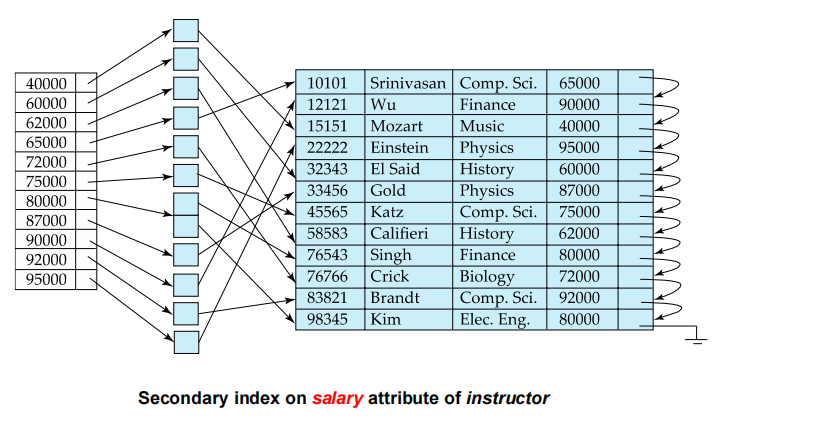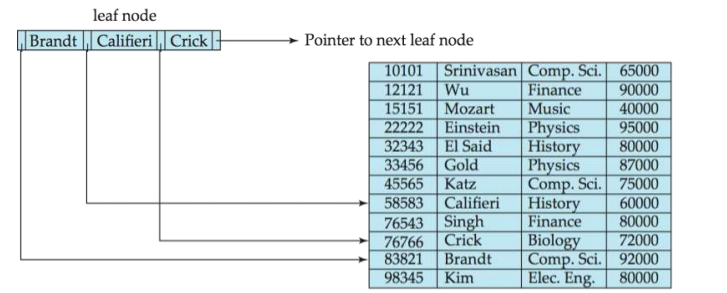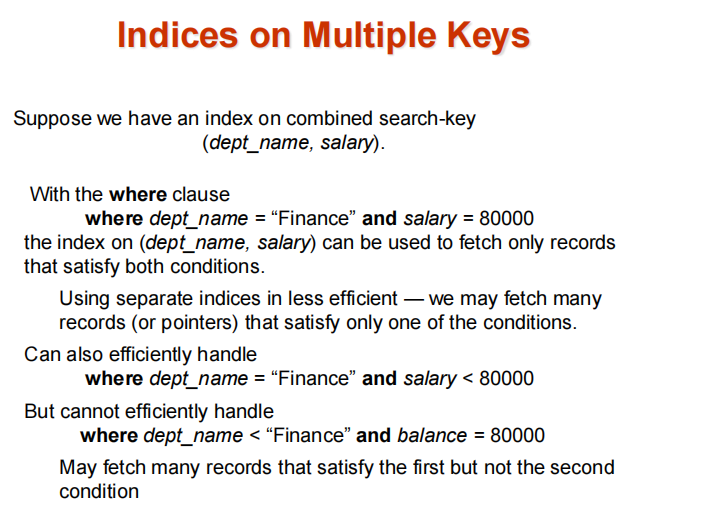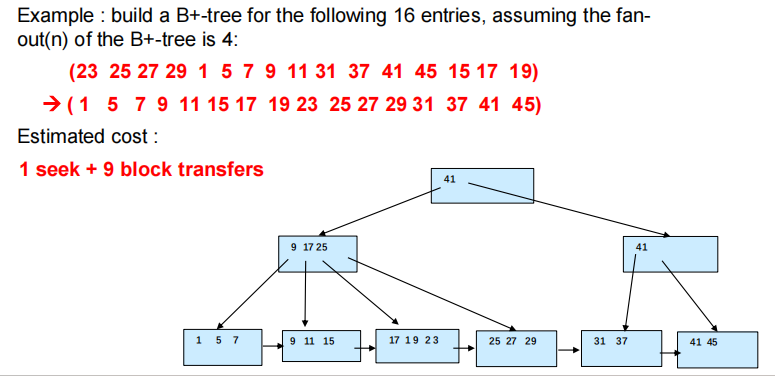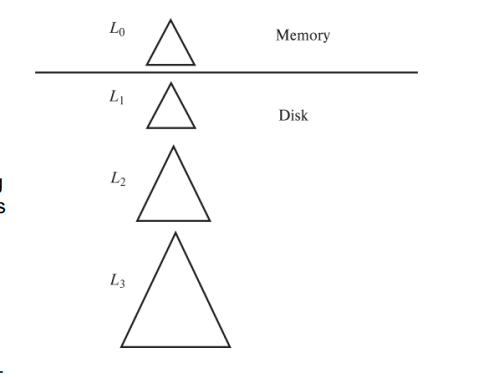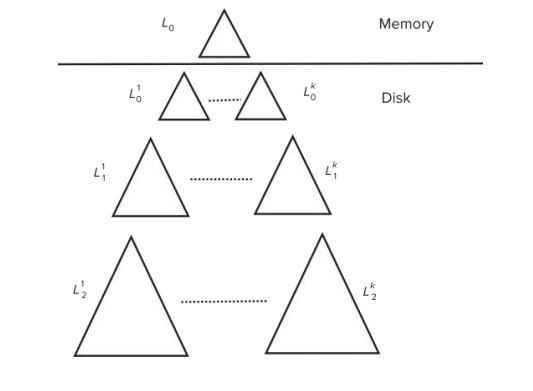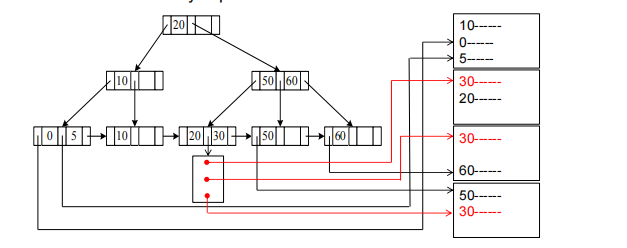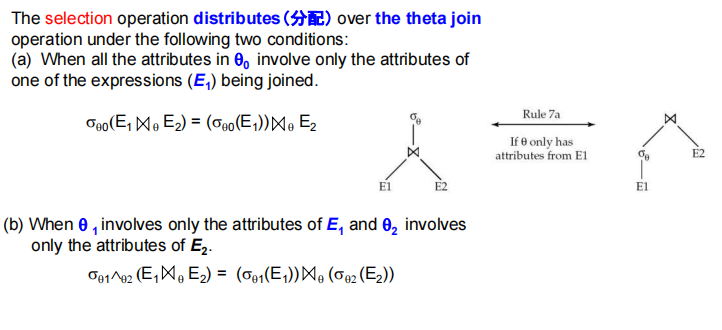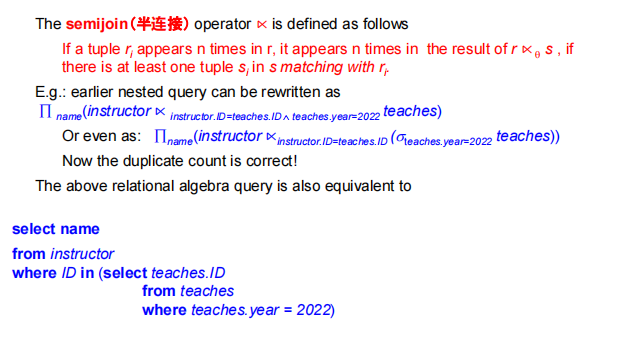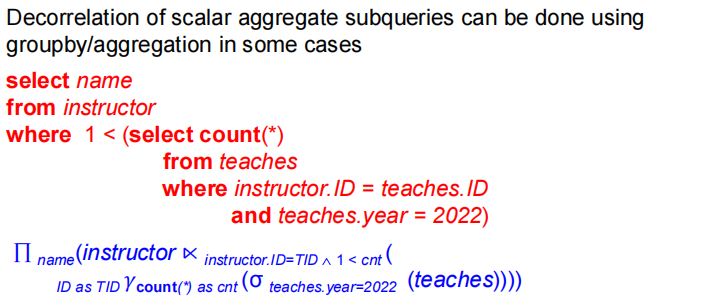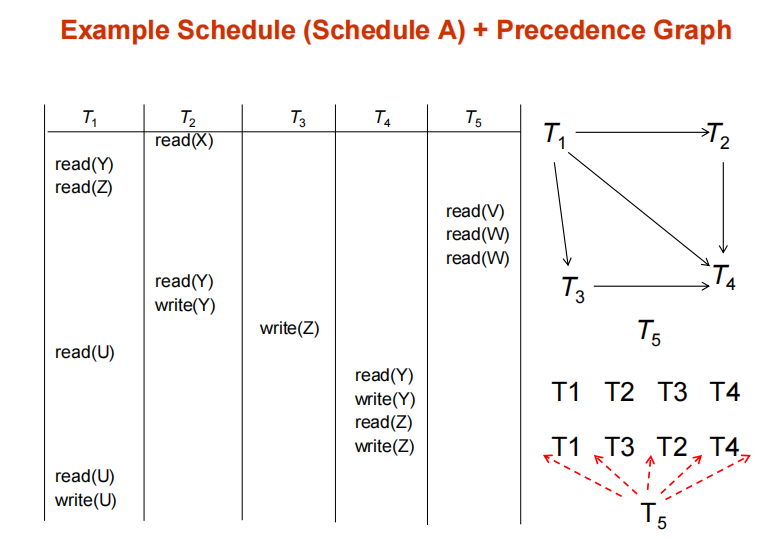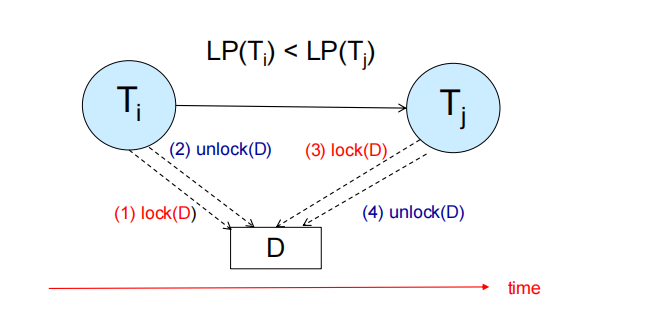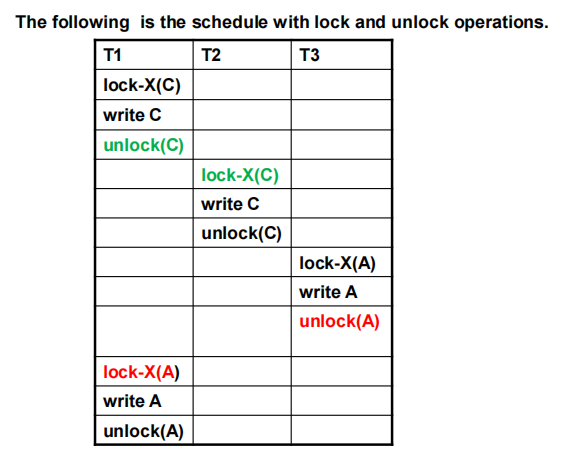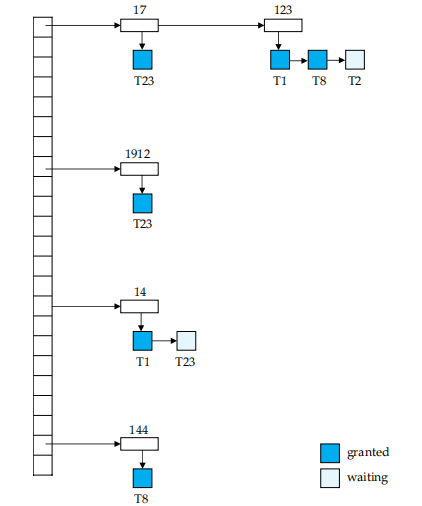
Database system
导航
- 导航
- introduction
- chapter2-Relational Model
- chapter3-introduction to SQL
- chapter4-intermediate SQL
- chapter5-advanced SQL
- chapter6-E-R Model
- chapter7-Relational Database Design
- chpater12-Physical storage systems
- chapter13-Data storage structures
- chapter14-Indexing
- chapter15-Query Processing
- chapter16-Query Optimization
- Chapter 17-Transactions
- Chapter 18-Concurrency Control
- chapter19-Recovery system
introduction
purpose of database system
- 早期database application建立在file systems上有data redundancy,data isolation,difficulty in accessing data等问题。
- integrity problems(完整性问题)
在数据库中integrity constraints can be stated explicitly. - Atomicity problems(原子性问题)
在数据库中主要通过恢复功能来解决原子性问题。 - concurrent access anomalies(并发访问异常)
对于并发操作若不采取任何限制,可能会导致数据混乱。 - Security problems
数据库系统提供以上问题的解决措施。
Characteristics of Databases
- data persistence
- convenience in accessing data
- data integrity
- data security
- concurrency control for multiple users
- failure recovery
view of data
- 三级抽象databases(Hide the complexities,enhance the adaptation to changes)
- 主要通过两层map来体现数据库的物理数据独立性和逻辑数据独立性。
- view level
- logical level
- physical level
data Models
most important:Relational Model
Database languages
Data Definition Langauge(数据定义语言)
- DDL compiler generates a set of table templates stored in a data dictionary
- Data dictionary contains metadata
Data Manipulation Language(数据操作语言)
SQL:widely used non-procedural language(陈述式语言)
1
2
3select name
from instructor
where instructor.ID = '12345'
Database Design
- Entity Relationship Model(实体-联系模型)
- Normalization Theory
Database Engine
Storage manager
chapter2-Relational Model
Basic Structure
- 定义:Formally, given sets D1, D2, …. Dn a relation r is a subset of D1 x D2 x … x Dn.Thus, a relation is a set of n-tuples (a1, a2, …, an) where each ai $\in$ Di。也就是说虽然我们可视化展示的是一个列表,但是本质是没有顺序的,因为是一个集合。
- A1,A2….An are attributes
- R=(A1,A2,..,An) is a relation schema(也就是体现了关系的结构)
- Database shcema – is the logic structure of the database.
Attributes
- The set of allowed values for each attribute is called the domain(域) of the attribute.
- 通常值是原子的.
- 在数据库中为每一个域都规定了相同的空值.
keys
- 定义:K$\in$R.K is a superkey(超健) of R if values for K are sufficient to identify a unique tuple of each possible relation r(R).
- Example: {ID} and {ID,name} are both superkeys of instructor.(但是名字不是,因为存在重名的情况)
- Superkey K is a candidate key(候选健) if K is minimal.
- Example: {ID} is a candidate key of instructor.
- One of the candidate keys is selected to be the primary key(主键).
- Foreign key(外键) constraint from attribute(s) A of relation r1 to the primary key B of relation r2 states that on any database instance, the value of A for each tuple in r1 must also be the value of B for some tuple in r2. (参照完整性,类似于外键限制,但是并不一定局限于主键)

解释:由上面的例子,第三排的course中的dept_name就是外键,因为course中的dept_name和department中的dept_name(是主键)是同一个值,所以course中的dept_name就是外键。
解释:红色箭头表示参照完整性,黑键则表示外键。
Relational Algebra
- 输入几个关系,通过某个操作得到一个新的关系。
- Six basic operations:
- select(横向选择)$\theta$
- project(投影某几列,并且结果会去重,因为关系本质上就是集合)$\pi$
- union(对两个关系并起来)
- 两个关系必须有相同的元数–arity(same number of attributes)
- attributes的域需要相容
- set difference -
- $r - s = {t| t \in r \land t \notin s}$
- 这个操作的要求也与union相同,两个关系必须有相同的元数且域相容
- 笛卡尔积(表的乘积) x
- rename $\rho$ (当对一个关系想做笛卡尔积的时候,可以对其改名再执行笛卡尔积)
Additional Operations
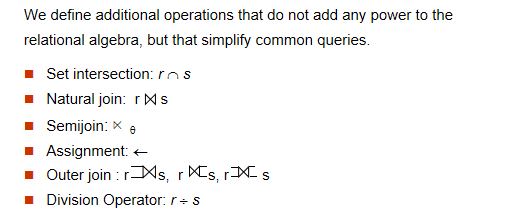
- set-intersection operation
- 和set-intersection操作相反,就是求两个关系交集
- 但是操作的要求也与 set difference相同,两个关系必须有相同的元数且域相容
- 自然联结
- 相当于在笛卡尔积上 添加一个条件,要求两个关系中必须包含相同的元组。
- Theta Join
- 自然连接的放宽版本,我们可以指定寻找连接两个关系时哪一个元组作为桥梁。
- Outer Join
- 自然连接的放宽版本,进一步避免信息的遗失。
- 比如当我们选择Left Outer Join,那么左表的所有列都会保留,并且未成功和右表匹配的列,使用NULL来填充右表相应的信息。
- 如果是Full Outer join,那么左右两表的相关信息都会保留。
- Semijoin operation
- Theta join的扩展
- 半连接是一种特殊的连接操作,它的目的是找出在一个关系(表)中存在,并且在另一个关系(表)中满足连接条件的元组(行)。与内连接(INNER JOIN)不同,内连接会返回两个表中匹配行的所有列的组合,而半连接只返回左表(或右表,取决于具体操作符)中满足条件的行,且每行只返回一次。 它不返回右表中的任何列。
- 除法操作
- 用一个通俗的说法来解释:除数的关系一定是被除数关系的子集,结果里面的元组与除数元组连接一定在被除的关系中
Extended Relational-Algebra-Operations
Generalized Projection
Aggregate Functions
- 聚合函数,顾名思义就是输入一系列值最后输出一个值的函数,比如求和、平均值、最大值、最小值等。
- example:求取每一个department的所有instructor的平均工资:$dept-name G_{avg}(salary) as avg_sal(instructor)$,其中前面的dept-name表示按照dept-name进行分组操作
chapter3-introduction to SQL
Data Definition Langauge
Domain Types in SQL
- char(n). Fixed length character string, with user-specified length n.(与C语言有差异,因为C语言的字符串的结尾一定为\0,它以字符数组的形式存储,而数据库作为字典直接可以从存储中截取对应长度,不需要额外的标识符)
- varchar(n). Variable length character strings, with user-specified maximum length n.
- int. Integer (a finite subset of the integers that is machine-dependent).
- smallint. Small integer (a machine-dependent subset of the integer domain type).
- numeric(p,d). Fixed point number, with user-specified precision of p digits, with d digits to the right of decimal point.
→ number(3,1) allows 44.5 to be store exactly, but neither 444.5 or 0.32 - real, double precision. Floating point and double-precision floating point numbers, with machine-dependent precision.
- float(n). Floating point number, with user-specified precision of at least n digits.
Built-in Data Types in SQL
- date
- time
- timestamp(data plus time of day)
- interval(period of time)
Create Table Construct
1 | |
- 因为我们创建一个表的时候还需要关注完整性,所以再研究一下key
- 设置主键:primary key(A1,…,An)
- 设置外键:foreign key(Am,…An) references r(对于被引用的表如果发生delete或者update,可以进行这四个操作:cascade(那个表的值怎样变,此表的值就怎么变), restrict(限制不变), set null, set default)
特性 主键(Primary Key) 外键(Foreign Key) 作用 唯一标识表中的每一行数据。 维护表之间的关联,保证参照完整性。 数量 一个表只能有一个主键。 一个表可以有多个外键。 空值 不允许为空( NOT NULL)。可以为空(如果业务允许,例如员工可以暂时没有部门)。 唯一性 必须唯一。 不要求唯一,可以重复(例如多个员工属于同一个部门)。 引用 不引用其他表。 引用其他表的主键或唯一键。 行为 无特殊行为(针对被引用表的删除/更新)。 定义了 ON DELETE和ON UPDATE的级联行为。
| 操作类型 | 描述 | 示例场景 |
|---|---|---|
| CASCADE | 被引用表数据变化时,当前表相关数据自动同步变化。 | 删除部门时自动删除员工记录 |
| RESTRICT | 如果当前表有依赖数据,则拒绝被引用表的数据变化。 | 防止删除仍有员工的部门 |
| SET NULL | 被引用表数据变化时,当前表相关外键字段被设置为 NULL。 |
删除部门时将员工的部门字段置空 |
| SET DEFAULT | 被引用表数据变化时,当前表相关外键字段被设置为默认值。 | 删除部门时将员工的部门字段设为默认 |
1 | |
Drop and Alter Table constructs
1 | |
Basic Query Structure
The select clause
- SQL 大小写不分的
- find the names of all instructors
- select name
- from instructor
- 增加关键字
distinct:能够在输出的时候删除重复项 - 增加关键字
all:显式说明重复项不会被删除 - 同样select的clause扩展了算术操作
1 | |
The where clause
- 条件查询中提供条件的限制
- SQL也提供了
between作为比较操作符
The from clause
- The from clause lists the relations involved in the query
- Corresponds to the Cartesian product operation of the relational algebra
Natural join example
1 | |
- 但是我们在查询时对于natural join的使用需要慎重,因为natural join会隐式使用相同元组的等式关系进行构建,但有些等价关系在某些查询时可能并不需要
The rename operation
- 在SQL中允许我们使用as clause进行重命名,例如
old-name as new-name
string operations
- SQL中引入了”like”操作符,用于匹配字符串,例如
%表示任意子字符串,_表示任意一个字符
Ordering the display of tuples
1 | |
duplicates
set operations
- union
- intersect
- except
Null values
- null表示未知值或不存在的值。任何涉及null的算术表达式的结果都是null。例如:5 + null返回null。谓词
is null可用于检查是否存在null值。
Aggregate Functions
- 常见的聚合函数
- avg:average value
- min:minimum value
- max:maximum value
- sum:sum of values
- count:number of values
- 如果集合全为null,只有它这个聚合函数返回0,其余聚合函数返回null
group by
当我们使用group by以后,如果原来表的某一个字段并不是我们的group by分组依据,并且我们没有用聚合函数对于这个属性进行聚合,那么此时的select存在错误。
1
2
3
4/* 错误 */
select dept_name,id,avg(salary)
from instructor
group by dept_name;
Having clause
- having类似于where对于条件进行限制,只是having是在group by之后进行限制,而where是在group by之前进行限制。
1 | |
- 聚合函数的使用
- 直接使用聚合函数:适用于对整个表或满足某些条件的数据进行聚合操作。
- 结合 GROUP BY 使用聚合函数:适用于按某个字段分组后对每组分别进行聚合操作。
- 因此,是否需要 GROUP BY 取决于具体的业务需求。如果只是对整体数据进行统计,无需分组;如果需要按某些字段分组统计,则必须使用 GROUP BY。
1 | |
Nested Subqueries
Set membership
- 通过in和not in来实现嵌套操作
1 | |
set comparison
- 利用some和all与给定集合进行比较
1 | |
Scalar subquery
- scalar subquery is one which is used where a single value is expected
- 如果子查询返回不止一个元组则会出现报错
test for empty relations
- 利用exists和not exists
1 | |
- 一个很巧妙的例子(找到上完某个department提供的所有课程的一位学生)
- 我们将这个查询转化一下,也就是说没有一个department提供的课程,这个学生没上过
1 | |
Test for absence of duplicate tuples
- the
uniqueconstruct tests whether a subquery has any duplicate tuples.
Modification of the Database
delete
1 | |
insertion
1 | |
update
chapter4-intermediate SQL
joined relations
- join types
- inner join(默认的笛卡尔积均是inner join)
- left outer join(from后面的表的所有列均保留,如果没有成功连接上,则置为NULL)
- right outer join(join后面的表的所有列均保留)
- full outer join
- join conditions
- natural join(自然连接)
- on condition(条件连接)
- using(A1,…,An)(等值连接)
- example
- 统计每个老师教的课程(但是可能包含没有课程的老师)
- select id,count(course_id)
- from instructor natural left outer join teaches
- group by id;
- 统计每个老师教的课程(但是可能包含没有课程的老师)
SQL Data Types and schemas
User-defined types
- create type construct in SQL creates user-defined type
create type Dollars as numeric(12,2) final
domains
- domain is a user-defined type that specifies a set of values and a set of constraints on the values in the set.domains相比于types,domain可以定义一些约束,比如长度,范围,正则表达式等。
- craete domain person_name char(20) not null
integrity constraints
Not NULL and Unique constraints
referential integrity
- 确保在另一个关系中,对于给定的属性集出现的一个值也出现在另一组属性中
- 例如:如果“生物学”是出现在教师关系中的一个元组中的系名,那么在系关系中就存在一个关于“生物学”的元组。
- 回顾外键定义与性质:设A为一组属性,R和S是两个包含属性A的关系,其中A是S的主键。若R中出现的所有A值在S中也存在,则称A为R的外键。可见外键也是一种约束。
the check clause
views
- A view provides a mechanism to hide certain data
from the view of certain users.(虚拟的表,没有实际存在) - 好处:简化复杂性,适应能力增加,提供安全权限管理功能。
view definition
create view v as <query expression>
example views
- a view of instructors without their salary
- create view faculty as
select ID, name, dept_name
from instructor; - 当我们创建好这个view以后,我们可以把这个view当作实体的表进行表的各种操作
- create view faculty as
views defined using other views
- 在定义view的基础上,可以再定义一个view
- create view physics_fall_2009 as
select course.course_id, sec_id, building, room_number
from course, section
where course.course_id = section.course_id
and course.dept_name = ’Physics’
and section.semester = ’Fall’
and section.year = ’2009’; - create view physics_fall_2009_watson as
select course_id, room_number
from physics_fall_2009
where building= ’Watson’; - 这样的操作其实我们可以在一个语句中实现
select course_id, room_number
from physics_fall_2009(已经创建的view)
where building= ’Watson’;
→
select course_id, room_number
from (select course.course_id, building, room_number
from course, section
where course.course_id = section.course_id
and course.dept_name = ’Physics’
and section.semester = ’Fall’
and section.year = ’2009’)(把view创建的语句嵌套在from中)
where building= ’Watson’;
→
select course_id, room_number
from course, section
where course.course_id = section.course_id
and course.dept_name = ’Physics’
and section.semester = ’Fall’
and section.year = ’2009’
and building= ’Watson’;(sql本质运行的一种语句)
update of a view
- view相当于只是打开一扇窗,所以对view的修改,实际上是对view的表进行修改。当然孙老师说,为了提高查询的高效性,有些时候确实会创建一个临时表(materialized view)。
- example
insert into faculty values (’30765’, ’Green’, ’Music’);
insert into instructor values (’30765’, ’Green’, ’Music’, null); - 但是有些时候view的update不能被翻译为对原始表的独立的操作,因为这个view选取的元素可能不是超键。
- 因此现在目前的大多SQL只能对简单的视图进行更新
view and logical data dependence
- 当我们底层的物理数据发生变化,比如一个表分成了两个表,因为我们用户层面可能用到原来的表,那么我们可以利用现在的两个表生成一个代表原来表的view,对于用户层面没有任何变化,但是底层逻辑发生改变。
Indexes
- 索引的创建,更多的内容放在第十四章具体介绍
transactions
- 在数据库系统中,事务是指一组操作的集合,这些操作要么全部执行成功,要么全部不执行,以确保数据的一致性和完整性。
transaction properties
- ACID(自我感觉挺重要的)
- 原子性(Atomicity):事务是一个不可分割的工作单位,事务中的所有操作要么都做,要么都不做。
- 一致性(Consistency):事务必须使数据库从一个一致状态变换到另一个一致状态。如果事务执行成功,则数据库处于一致状态;如果事务执行失败,则数据库应恢复到事务开始前的状态。
- 隔离性(Isolation):多个事务并发执行时,一个事务的执行不应影响其他事务的执行结果。每个事务都应该独立运行,就好像它是唯一正在运行的事务一样。
- 持久性(Durability):一旦事务提交,它对数据库的更改应该是永久性的,即使系统发生故障。
transaction example
SET AUTOCOMMIT=0;
UPDATE account SET balance=balance -100 WHERE ano=‘1001’;
UPDATE account SET balance=balance+100 WHERE ano=‘1002’;
COMMIT;(上一条事务结束,下一个事务开始)
UPDATE account SET balance=balance -200 WHERE ano=‘1003’;
UPDATE account SET balance=balance+200 WHERE ano=‘1004’;
COMMIT;
UPDATE account SET balance=balance+balance*2.5%;
COMMIT;
transaction operation
- BEGIN TRANSACTION; 或 START TRANSACTION;:显式地开始一个新的事务。
- COMMIT;:提交当前事务,使其所有更改永久生效。
- ROLLBACK;:回滚当前事务,撤销所有未提交的更改,是数据库恢复到事务开始之前的状态。
- SAVEPOINT savepoint_name;:设置一个保存点,可以在部分回滚时使用。
- ROLLBACK TO savepoint_name;:回滚到指定的保存点,而不是整个事务。
Autorization
- 对于数据库的操作的授权
- select
- insert
- update
- delete
- 修改数据库模式的授权
- Resuorces(Create in MySQL)
- Alteration
- Drop
- Index
- Create view(MySQL)
- the grant statement is used to confer authorization:grant (privilege list) on (relation name or view name) to (user list)
- user list:
- user-id
- public,which allows all valid the privilege granted
- a role(more on this later),作用周期是永久性的,角色也就是用户的集合,可以创建角色,然后给角色授予权限。
privileges in SQL
grant select on instructor to U1, U2, U3
grant select on department to public
grant update (budget) on department to U1,U2
grant all privileges on department to U1
- the revoke statement is used to revoke authorization:revoke (privilege list) on (relation name or view name) from (user list)
chapter5-advanced SQL
Accessing SQL from a programming language
- two approaches to access database
- API
- Embedded SQL
API
- ODBC works with C,C++,C#
- JDBC works with Java
- Open a connection
- Create a “statement” object
- Execute queries using the Statement object to send queries and fetch results
- Exception mechanism to handle errors
- Embedded SQL in C
- SQLC-embedded SQL in Java
- JPA-OR mapping of Java
JDBC
JDBC code
1 | |
Prepared Statement
- 先生成,类型未知,再利用set语句和update语句进行更新
- prepared statement也可以避免SQL注入攻击,因为我们提前进行编译,就会防止产生SQL的歧义。
1 | |
Metadata
- JDBC可以利用getMetaData()方法来获取数据库的元数据,比如列名,列类型,列数目等。
ODBC(open database connectivity)
ODBC Code
- 完全通过函数调用实现
1 | |
main body
1 | |
ODBC prepared statements
Embedded SQL
procedural constructs in SQL
SQL functions
- 定义函数后再调用
- sql函数组成:
- 函数名,传入参数
- 第二行便需要写返回值
- 开始begin end代码块(这个代码块的最后也需要将返回值返回出去)
- sql函数组成:
- 在SQL2003以后,返回值允许是整个table
1 | |
SQL procedures
- procedures与函数存在最大的不同点就是在函数的定义中便存在明确的输入和输出。
- 所以我们不需要return语句将值返回。
- 当然在调用时,类似于c语言中传递一个目标返回值的指针进去
1 | |
procedural constructs
- 不同的SQL可能支持的功能或者相同功能的语法存在差异。
Triggers
- A trigger is a statement that is executed automatically by the system as a side effect of a modification to the database.
- ECA rule
- Event: A modification to the database(insert,delete,update)
- Condition: A condition that must be satisfied for the trigger to execute
- Action: An action to be performed when the condition is satisfied
Trigger example
1 | |
Statement Level Triggers
chapter6-E-R Model
E-R Diagram
- section:弱实体,自己的属性不能表示唯一的实体,所以通过sec_course等relationship,则可以表示section依赖course等,就能够唯一确定section。我们也发现section的某个属性下方为虚线,它需要与它所依赖的主键组合起来成为主键。
chapter7-Relational Database Design
deposition
- 因为我们想要获得更小的表,所以要将原来的relation进行分解,但是此时分解存在两种情况:
- lossy decomposition: 丢失一些信息,分解后的表通过natural join以后不能重构得到原来的表。
- lossless decomposition:$\pi_{R_1}(r) \natural \pi_{R_2}(r) = r $
- lossless decomposition的充要条件是至少满足以下两个条件之一:R1与R2的交集为R1的超键,或者R1与R2的交集为R2的超键。
Functional Dependencies
- 函数依赖是对一组合法关系(满足所有这些现实世界约束关系的一个实例称为该关系的合法实例)的约束,要求某一组属性的值能够唯一确定另一组属性的值。
dept_name→building是一种函数依赖,它是键概念的一种泛化。 - 我们用数学化的语言表达:R be a relation schema,$\alpha \subseteq R \text{and} \beta \subseteq R$ The function dependency $\alpha \rightarrow \beta$ is defined as:对于任意的两个元组满足$t_1[\alpha] = t_2[\alpha] \Rightarrow t_1[\beta] = t_2[\beta]$
- 通过函数依赖的定义,我们可以将前面章节提到的键的定义用函数依赖的方式表达
- A functional dependency is trival if it is satisfied by all relations
closure of a set of functional dependencies
- 给定一组函数依赖F,存在一些其他函数依赖在逻辑上被F所蕴含。例如:如果A→B且B→C,那么可以推断出A→C。所有由F逻辑蕴含的函数依赖的集合即为F的闭包。
- 那么如何求取F的闭包呢?我们可以运用Armstrong’s Axiom
- $\text{if} \beta \subseteq \alpha \text{, then} \alpha \rightarrow \beta$
- $\text{if } \alpha \rightarrow \beta \text{, then } \gamma \alpha \rightarrow \gamma \beta$
- 传递率
- 根据上面三条基本定律可以扩展如下规则
- $\text{if} \alpha \rightarrow \beta \text{,holds and} \alpha \rightarrow \gamma \text{,then} \alpha \rightarrow \beta \gamma$ 合并率
- $\text{if} \alpha \rightarrow \beta \gamma \text{holds,then } \alpha \rightarrow \beta \text{and }\alpha \rightarrow \gamma \text{ holds}$ 分解率
closure of attribute sets
- 给定一组属性a,定义a在F下的闭包(记作a+)为由a在F下功能决定的属性集合。
- 也就是说,能够通过给定属性,依照函数依赖关系能得到的属性的集合。如果这组属性的闭包是所有属性,那么这组属性就是超键。
Canonical cover
- 一组函数依赖关系中可能存在冗余的依赖,这些冗余依赖可以从其他依赖关系中推断出来。例如:在{A→B,B→C,A→C}中,A→C是冗余的。
- a canonical cover of F is a “minimal” set of functional dependencies equivalent to F, having no redundant dependencies or
redundant parts of dependencies
Extraneous attributes
- 一个属性在函数依赖 X→Y 中被称为“无关属性”,如果移除该属性后,函数依赖仍然成立。无关属性可以出现在函数依赖的左侧 (Left-hand side, LHS) 或 右侧 (Right-hand side, RHS)。
compute a canonical cover
- 重复以下操作
- 使用合并规则,合并F中的所有函数依赖
- 对于某个函数依赖,如果存在无关属性那么需要把这个无关属性去掉
- 直到F不再发生任何变化
- 当然通过画图的方式也能够得到我们想要的正则覆盖,对于每个属性都相当于图的节点,有向图的边代表的这两个属性间存在依赖关系。
Norm form
Boyce-codd Normal Form
- 定义:若关系模式R相对于函数依赖集F中的所有函数依赖形式都满足($\alpha \rightarrow \beta \text{ satifies,} \alpha \rightarrow \beta \text{ is triaval or }\alpha \text{ is a superkey for R}$),则该模式属于BCNF。
decomposing a schema into BCNF
- 分解后子关系的函数依赖集包含所有属于原函数依赖的闭包,且完全由该子关系属性构成的函数
依赖,无论这些依赖在原始F中是显式声明还是隐式存在 - 这个分解是lossless-join
- 算法如下
- 每次都查看当前是否这个关系模式不满足BCNF范式
- 对于这个不满足BCNF范式的关系,找到不满足条件的函数依赖$\alpha \rightarrow \beta$
- $\text{result:=(result - Ri)} \cup (Ri - \beta) \cup (\alpha,\beta)$
- 每次都查看当前是否这个关系模式不满足BCNF范式
BCNF and Dependency Preservation
- (如果通过检验单一关系上的函数依赖,就能确保所有的函数依赖成立,那么这样的分解是依赖保持的)
(或者,原来关系R上的每一个函数依赖,都可以在分解后的单一关系上得到检验或者推导得到,并不局限于一个子关系,也就是子关系函数依赖的并集。) - 但是通常使用BCNF分解后很难同时满足函数依赖的保持,所以我们引入较弱的范式。
Third Normal Form:Motivation
- There is always a lossless-join, dependency-preserving decomposition into 3NF
- Third condition is a minimal relaxation of BCNF to ensure dependency
preservation - 定义:如果一个关系满足三范式,那么对于这个关系的所有函数依赖都需要满足三个条件之一(其中两个条件是BCNF的要求,另外还有一个条件,可见放宽了要求)
$$
\text{Each attribute A in }\beta - \alpha \text{ is contained in a candidate key for R}
$$
3NF decomposition algorithm
- 首先从F的正则覆盖出发,将里面的每一个函数依赖左右两侧的属性都放进单独一个关系中。
- 经过以上操作后,如果没有任何一个子关系包含原来关系的候选键,那么新增一个子关系,这个子关系由R的任意一个候选键组成。
- 可选操作:将冗余的子关系除去
goals of normalization
- 如果关系模式R不符合“良好”形式,可以将其分解为一组关系模式{R1,R2,…,Rn },确保每个关系模式都处于良好的形式(即BCNF或3NF),并且这种分解是无损连接的。理想情况下,这种分解还应保持依赖性。
Multivated dependencies
- 多值依赖描述的是一个表中,某个属性(或属性集)的值,独立地决定了另外两个或多个属性集的值,而这些被决定的属性集之间是相互独立的。
- 本质上多值依赖就是函数依赖的推广
更具体地说,对于一个关系 $R$ (表),如果存在属性集 $A, B, C$,且 $B$ 和 $C$ 是 $R$ 的非空子集,并且 $B \cap C = \emptyset$,那么我们称 $A$ 多值决定 $B$(表示为 $A \twoheadrightarrow B$),如果对于 $R$ 中的任何两个元组 $t_1$ 和 $t_2$,满足 $t_1[A] = t_2[A]$,那么在 $R$ 中必然存在两个元组 $t_3$ 和 $t_4$,使得:
- $t_3[A] = t_4[A] = t_1[A]$
- $t_3[B] = t_1[B]$ 且 $t_4[B] = t_2[B]$
- $t_3[C] = t_2[C]$ 且 $t_4[C] = t_1[C]$
简单来说,就是当 $A$ 确定时,$B$ 的所有可能值与 $C$ 的所有可能值之间是完全独立的。改变 $B$ 的值不会影响 $C$ 的值,反之亦然。
Fourth Normal Form
- A relation schema R is in 4NF with respect to a set D of functional and multivalued dependencies if for all multivalued dependencies in D+ of the form $\alpha$ →→ $\beta$, where $\alpha \subseteq$ R and $\beta \subseteq $ R, at least one of the following
hold:
◆ trivial (i.e., $\beta \subseteq \alpha $ or $\alpha \cup \beta$ = R)
◆ $\alpha$ is a superkey for schema R - 由定义可以知道,在 4NF 中,除了由超键决定的多值依赖(即函数依赖),不应该存在其他多值依赖。它消除了在一个表中同时存在多个独立的多对多关系所导致的冗余。
- 4NF 解决的问题:
4NF 解决了当一个实体同时拥有多个相互独立的多值属性时,数据冗余的问题。这些冗余无法通过函数依赖来消除。
4NF decomposition algorithm
- 分解步骤类似BCNF:查找违规:在Ri中找到一个非平凡的多值依赖 A↠B(其中 B 不在 A 中,且 A∪B!=Ri),并且 A 不是 Ri的超键。
注意:如果找不到这样的多值依赖,但存在违反 BCNF 的函数依赖,则应先执行 BCNF 分解。理论上 4NF 的前提是 BCNF,所以实际操作中会先确保 BCNF。
E-R Modeling and Normal Forms
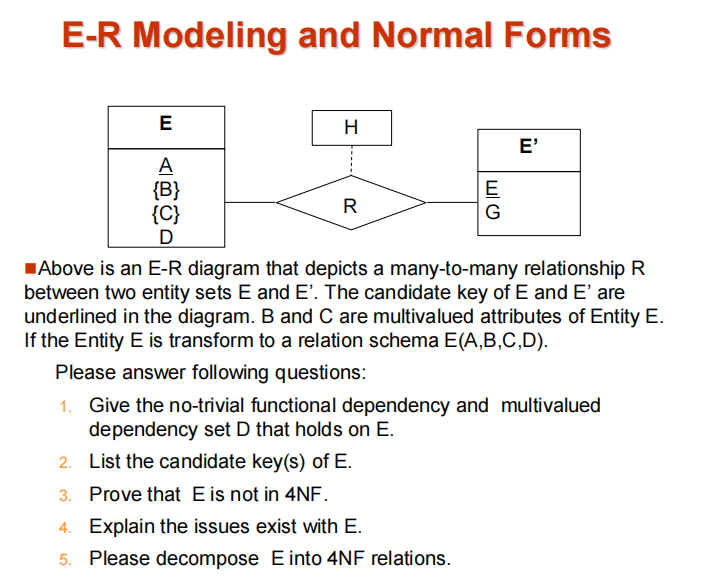
解释:将E-R图转化为关系表示我感觉可能是一个考点。在上图中,{}代表的是多值属性,所以相对应的依赖关系是多值依赖。这是最主要的区别。相应的解答如下。
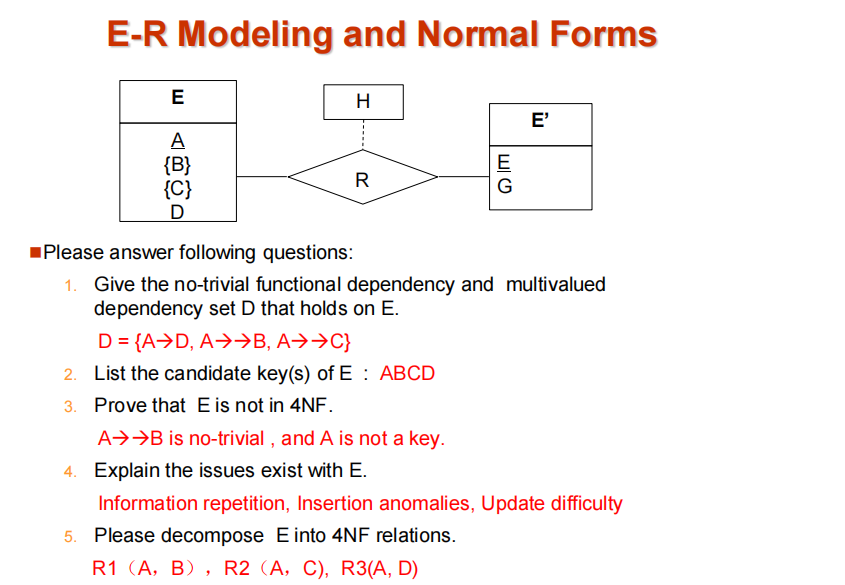
chpater12-Physical storage systems
classification of physical storage media
- volatile storage(易失存储):loses contents when power is turned off
- non-volatile storage(非易失存储):contents persist when power is turned off
- 我们评估存储的性能:
- speed with which data can be accessed
- cost per unit of data
- reliability
stroage hierarchy

- 主要存储:最快的介质,但易失性(缓存、主内存)。次级存储:层次结构的下一级,非易失性的,访问速度适中,也称为在线存储。例如闪存、磁盘。三级存储:层次结构的最底层,非易失性的,访问速度较慢,也称为离线存储。例如磁带、光存储。
Magnetic Disks
- 读写头位于盘片表面的非常近的位置(几乎接触盘片),以磁性方式读取或写入编码信息。
- tracks:盘片表面被划分为圆形轨道
- Each track is divided into sectors(扇区)
- 扇区是最小的能够被读写的单元
- 扇区大小为512字节
- 通常每一个磁道有500-1000个扇区
- disk controller:计算机系统与磁盘驱动器硬件之间的接口。
- 接受高级命令来读取或写入扇区,启动诸如将磁盘臂移动到右侧轨道并实际读取或写入数据等操作。计算并为每个扇区附加校验和以验证数据是否被正确读回。通过在写入扇区后回读该扇区来确保成功写入。并执行坏扇区的重新映射
performance measures of disks
- access time:从发出读或写请求到开始数据传输所需的时间。
- seek time:重新定位机械臂到正确轨道所需的时间.通常的为4 to 10 milliseconds
- rotational latency:time it takes for the sector to be accessed to appear under the head.4 to 11 milliseconds on typical disks
- Data-transfer rate:the rate at which data can be retrieved from or stored to the disk.
- Disk block is a logical unit for storage allocation and retrieval.
- 访问模式
- 顺序访问模式
- 随机访问模式
- Mean time to failure:the average time the disk is expected to run continuously without any failure.
Optimization of Disk-Block Access
- Buffering:内存缓冲区用于缓存磁盘块。
- Read-ahead(预取):提前从磁道读取额外的块,以预测它们将很快被请求。
- 磁盘臂调度算法会重新排序块请求,从而最小化磁盘臂的移动。
- File organization:
- 以尽可能连续的方式分配文件块。以扩展(磁盘分区)为单位进行分配
- 非易失性写缓存(Nonvolatile write Buffer)-通过立即将数据块写入非易失性RAM缓冲区来加快磁盘写入速度
- 日志磁盘的使用
Flash Storage
- NAND闪存广泛用于存储,比NOR闪存更经济。
- NAND闪存需要逐页读取(每页512字节至4 KB)。顺序读取与随机读取之间的差异不大。
- 每个页面只能写入一次。必须先擦除才能重写
- 固态硬盘(SSD)使用标准的块状磁盘接口,但数据存储在多个内部闪存存储设备上。
chapter13-Data storage structures
- 数据库的文件架构
- The database is stored as a collection of files.
- Each file is a sequence of records.
- A record is a sequence of fields.
File Organization
Fixed-length records
- 所有记录的长度都相等,当发生删除时:
- 其中一种做法:
- move records i + 1, . . ., n to i, . . . , n – 1
- move record n to i
- 另一种做法:do not move records, but link all free records on a free list
- 其中一种做法:
Variable-length records
- Attributes are stored in order
- Variable length attributes represented by fixed size (offset, length), with actual data stored after all fixed length attributes
- Null values represented by null-value bitmap(空位图)
![database1]()
解释:这上面是一个例子,不定长的保存在后面,定长的与(offset,length)保存在前面。在这个例子中,null bitmap表示前面四个属性都是非空的。 - 存储variable-length records采用slotted page structure,whose header contains:
- number of record entries
- end of free space in the block
- location and size of each record
- 需要注意的是:Records can be moved around within a page to keep them contiguous with no empty space between them; entry in the header must be updated.
Record pointers should not point directly to record — instead they should point to the entry for the record in header.
Organization of records in files
- heap:有空余位置就插入
- 每一个block都有一个entry,维护一个空闲块地图,记录这个块的空闲程度。
- sequential:插入元素维护一个次序
- In a multitable clustering file organization records of several different relations can be stored in the same file。
- Motivation: store related records on the same block to minimize I/O
- B+tree file organization
- Hashing
heap file organization
- 记录可以放置在文件中任何有空闲空间的地方。分配后,记录通常不会移动。
- 能够高效地在文件中查找空闲空间非常重要。所以引入了free-space map
- 第一级 FSM(基础层)
数据结构:数组(每个块对应一个条目)。
条目大小:通常为 1字节(8位)或更少
编码规则:用数值表示块的空闲比例 (如3位可表示0–7,对应0/8至7/8的空闲比例)。
例如:011(二进制)= 3 → 表示块有 3/8 ≈ 37.5% 空闲空间。 - 第二级 FSM(聚合层)
目的:加速大范围空间搜索(避免逐块检查第一级FSM)。数据结构:更高层数组,每个条目存储下层若干块的最大空闲值。
- 第一级 FSM(基础层)
Sequential File Organization
- Suitable for applications that require sequential processing of the entire file
- The records in the file are ordered by a search-key
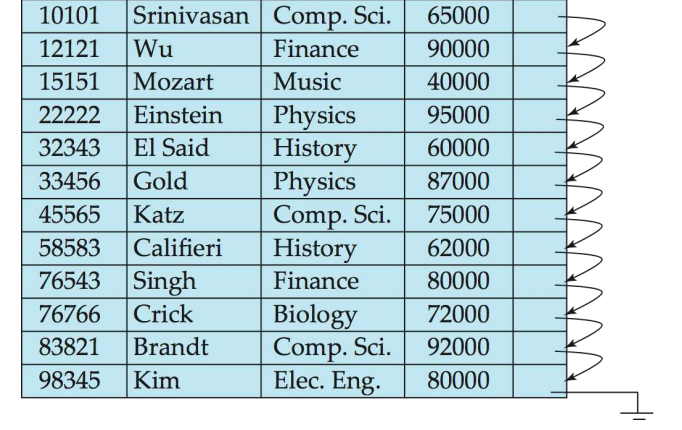
- 删除操作——使用指针链
- 插入操作——如果存在空闲空间,则定位记录应插入的位置;若无空闲空间,则直接插入;若无空闲空间,则将记录插入溢出块。无论哪种情况,均需更新指针链。
Multitable Clustering File Organization
- 核心思想是一个文件储存多个关系
- 优势:适用于涉及
部门、教师等多张表连接的查询,以及涉及单一部门及其教师的查询; - 劣势:但不适用于仅包含部门结果的查询
- 可以通过添加指针链来链接特定关系的记录。能够加速单表查找。
Table Partitioning
- 表分区:关系中的记录可以被分割成较小的关系,这些关系被单独存储
- 写入事务的查询必须访问所有分区中的记录,除非查询具有选择,例如year=2019,在这种情况下只需要一个分区
- 优势:
- Reduces costs of some operations such as free space management
- Allows different partitions to be stored on different storage devices
Data Dictionary Storage
- 数据字典(也称为系统目录)存储元数据,即关于数据的信息,包括关系名称、每个关系的属性类型和长度、视图定义、完整性约束、用户和会计信息(包括密码)、统计和描述性数据(如每个关系中的元组数量)、物理文件组织方式(顺序/哈希等)、关系的物理位置以及索引信息。
Storage Access
- Blocks are units of both storage allocation and data transfer.
- Database system seeks to minimize the number of block transfers between the disk and memory. We can reduce the number of disk accesses by keeping as many blocks as possible in main memory.
- Buffer – portion of main memory available to store copies of disk blocks.
- Buffer manager – subsystem responsible for allocating buffer space in main memory
Buffer Manager
- 这里的管理逻辑就和minisql实现的第一模块的buffer_manager相同,就不赘述了。
- Pinned block:不允许写回磁盘的内存块,说明此时有进程正在使用这个内存块。
- Pin done before operation on a block
- Unpin done after operation on a block
- 缓冲区的共享锁和独占锁
- 用于防止并发操作在页面内容移动或重组时读取内容,并确保每次只进行一次移动或重组。
- 读取者获得共享锁,而对块的更新则需要独占锁。
- 锁定规则如下:同一时间只能有一个进程获得独占锁;共享锁不能与独占锁同时存在;多个进程可以同时获得共享锁(本质上就是相容矩阵的扩展,详细见第十八章锁的相关内容)
Buffer-Replacement Policies
- LRU:最近最少使用算法,即最近没有被访问的块被淘汰。
- 但是LRU在某些情况下可能是很坏的策略,比如循环访问时
- 即时抛出策略——一旦该块的最后一个元组被处理完毕,立即释放该块所占用的空间
- 最近使用(MRU)策略——系统必须固定当前正在处理的块。在该块的最后一个元组被处理后,该块将被解除固定,并成为最近使用的块。
columnar-oriened storage
- 列式存储也称为列表示法,将关系的每个属性分别存储
- 优势:
- 如果只访问某些属性,则IO会减少
- CPU缓存性能得到改善
- 压缩得到改善
- 劣势:
- Cost of tuple reconstruction from columnar representation
- Cost of tuple deletion and update
- Cost of decompression
- 现代CPU架构上的向量处理本质上就是利用率列式存储的优势
- 列式存储与行式存储
- Columnar representation found to be more efficient for decision support than row-oriented representation
- Traditional row-oriented representation preferable for transaction processing
chapter14-Indexing
Basic Concepts
- 索引机制就是为了加速查找设置的
- 一些概念:
- search key:用于在文件中查找记录的属性集的属性
- 索引文件中存储的records的形式:由
search key和pointer组成 - 两种索引方式:
- 有序索引:搜索键按排序顺序存储
- 哈希索引:使用“哈希函数”将搜索键均匀地分布在“桶”中。
Ordered Indices
- Primary index:in a sequentially ordered file, the index whose search key specifies the sequential order of the file.
- 它也被叫做clustering index
![database145]()
- 它也被叫做clustering index
- Secondary index(辅助索引): an index whose search key specifies an order different from the sequential order of the file. Also called non-clustering index.(索引键指定的顺序与文件顺序不同)
![database146]()
- Dense index(稠密索引) — Index record appears for every search-key value in the file.
- Sparse Index(稀疏索引): contains index records for only some search-key values.
- 与密集索引相比:占用空间更少,插入和删除操作的维护开销更低。通常在查找记录时比密集索引慢。
- 一个良好的折中:稀疏索引为文件中的每个块(每个块存放多条记录)都设置了一个索引条目,对应于该块中最小的搜索键值
- multilevel index(多级索引):如果主索引无法完全加载到内存中,访问成本将显著增加。解决方法是:将存储在磁盘上的主索引视为一个顺序文件,并在其上构建一个稀疏索引。外索引即主索引的稀疏索引,内索引则是主索引文件。
B+-Tree Index
properties of B+-tree
- All paths from root to leaf are of the same length
- Inner node(not a root or a leaf): between [n/2] and n children.
- Leaf node: between [(n–1)/2] and n–1 values
- Special cases:
- If the root is not a leaf:
at least 2 children. - If the root is a leaf :
between 0 and (n–1)values.
- If the root is not a leaf:
B+-Tree Node Structure
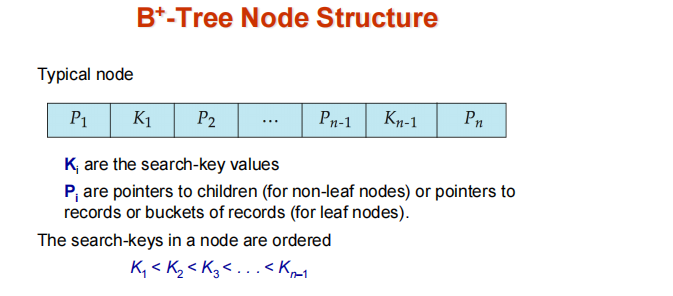
Leaf Nodes in B+-Trees
- 对于i = 1到2,…,n-1时,指针Pi指向具有搜索键值Ki的文件记录。
- 若Li和Lj为叶节点且i小于j,则Li的搜索键值不大于Lj的搜索键值。
- 指针Pn则指向按搜索键顺序排列的下一个叶节点。
![database147]()
Non-leaf Nodes in B+-Trees
- 非叶节点在叶节点上形成一个多级稀疏索引。
- For a non-leaf node with m pointers:
- P1: all the search-keys in the subtree to which P1 points are less than K1
- Pi(2 $\le$ i $\le$ n – 1): all the search-keys in the subtree to which Pi
points have values greater than or equal to Ki–1 and less than Ki - Pn: All the search-keys in the subtree to which Pn points have values greater than or equal to Kn–1
Non-Unique Search Keys
- 如果搜索键ai不是唯一的,那么请创建一个复合键(ai,Ap)的索引,该索引是唯一的
- 在这种情况下,如果想要利用这个符合键去检索ai的值的时候,其实就是另外一个属性的范围不加任何限制。
- 影响
- 键的额外存储开销
- 更简单的插入/删除代码
- 需要更多的I/O操作来获取实际记录
B+-tree:height and size estimation
- 最关键的是找到fan-out,因为按照我们上面提到的B+Tree Node structure,每一个fan都是由serch key和指针决定。我们的fan_out就是由
search key和指针的大小以及block size决定。 - 注意扇出计算的时候,因为n个指针分割n-1个(search key),所以扇出的数量最后要加1.
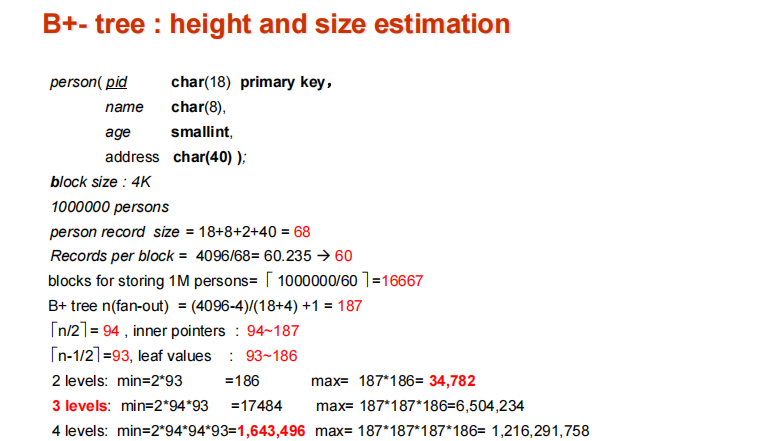
B+-File Organization
- B+-Tree File Organization:
- Leaf nodes in a B+-tree file organization store records, instead of pointers
- Helps keep data records clustered even when there are insertions/deletions/updates
- Leaf nodes are still required to be half full
- Since records are larger than pointers, the maximum number of records that can be stored in a leaf node is less than the number of pointers in a nonleaf node.
- Insertion and deletion are handled in the same way as insertion and deletion of entries in a B+-tree index.

- 由于记录占用的空间比指针多,因此良好的空间利用率非常重要。为了提高空间利用率,在拆分和合并期间将更多兄弟节点纳入重新分配
- 通过让两个兄弟节点参与数据重分配(尽可能避免分裂或合并),每个节点至少能拥有[2n/3]个条目。
Indexing strings
- 如果索引值为variable length strings,按照前面的思路我们可能得到不同的fanout。
- 解决:采用前缀压缩解决
Multiple-keys access
- 在B+树中,一个索引值可以包含多个属性。
- 对于解决一些特定的查询时速度很快
![database1410]()
- 对于解决一些特定的查询时速度很快
Indices on Multiple Keys
- Composite search keys are search keys containing more than one attribute。
- 大小的比较就根据属性的次序依次比较即可
Bulk Loading and Bottom-Up Build
- 将条目一次性插入B+树中,假设叶级无法装入内存,则每次需要大于1次IO开销,对于一次加载大量条目(批量加载)来说,这可能非常低效
- 以下两种选择的本质都是使用预计算,减少由于不确定性随机分裂导致的开销(最终写入磁盘的块数过多)
- 选择1:insert in sorted order
- 首先使用外部排序
- 再将索引顺序插入到B+树中
- 选择2:Bottom-up build
- 首先把所有索引排序
- 从叶子节点开始向上构造每一层
- The built B+-tree is written to disk using sequential I/O operations
![database149]()
解释开销:我们提前进行了排序,所以只进行一次seek,每将一个块写进磁盘进行一次transfer。
- 如果要批量插入较大规模的数据,我们可以直接合并为大的b+tree,然后使用bottom-up build方法构建。(其中原来的b+tree在磁盘中是连续存放的,所以我们归并时只要seek1次,然后连续读入block进行归并。最后构建好b+tree后再seek1次,并且通过block transfers写入磁盘)
Indexing in Main Memory
- Random access in memory
- Much cheaper than on disk/flash, but still expensive compared to cache read
- Binary search for a key value within a large B+-tree node results in many cache misses
- Data structures that make best use of cache preferable – cache conscious
- B+ -小节点的树更适合缓存行,以减少缓存未命中
- 总结:优化磁盘访问采用大节点,减少I/O开销;优化缓存采用小节点的树,减小cache miss.
Indexing on Flash
- Random I/O cost much lower on flash
- Write-optimized tree structures (i.e., LSM-tree) have been adapted to minimize page writes for flash-optimized search trees
Write optimized indices
- B+树在处理写入密集型工作负载时性能可能较差。
- 减少写入成本的两种方法:日志结构化合并树(LSM树)和缓冲树。
Log Structured Merge Tree
- 结构
![database143]()
- records inserted first into in-memory tree(L0 tree)
- 内存里的B+tree满了的话,就写入磁盘中。此时b+tree通过L0和L1采用自下而上的构建方式进行merge得到新的L1。
- 当L1超过某个阈值以后merge into L2,并且新树的阈值是原来树的阈值的倍数。
- benefits
- 减少IO次数,减少磁盘碎片化。
- 树始终是满的,提高空间利用率
- 始终顺序I/O操作。因为当使用LSM Tree的时候,数据先写到内存,满了再到磁盘,磁盘分级向下,始终是一个顺序的操作。
- drawbacks
- 查询必须搜索多棵树
- 内容都要复制多次(因为merge的缘故)
- stepped merge index
![database1411]()
- 是传统的LSM tree的变体,每一个level在磁盘上都有k棵树。当k个索引处于同一层时,合并得到一颗层数加一的树。
- 所以我们通过延迟merge,使得写入更便宜,但是查询变得更贵了。
- 优化查询的一个方法是使用Bloom filter
- 给每棵小树都配一个 Bloom Filter。查询一个 key 时,先检查 Bloom Filter,只有 Bloom filter 返回可能存在,才真正去访问磁盘文件。如果 Bloom filter 说肯定不存在,就可以跳过这个树,省下一次磁盘 I/O。
buffer tree
- 主要思想:B+树的每个内部节点都有一个缓冲区来存储插入
- 当缓冲区满时,插入操作将移动到较低级别。使用大缓冲区时,每次都会将许多记录移动到较低级别。每条记录的I/O会相应地减少
- 优点:查询开销更少,可与任何树索引结构一起使用,用于PostgreSQL广义搜索树(GiST)索引。
- 缺点:比LSM树更多的随机I/O
Bitmap indices
- 在最简单的形式中,属性的位图索引包含每个属性值的位图。位图的位数与记录数量相同。对于值v的位图,如果记录具有该属性的值v,则该记录对应的位为1,否则为0
chapter15-Query Processing
Basic steps in query processing
- by parser and translator to relational algebra expression
- amongst all equivalent evaluation plans choose the one with the lowest cost
- evaluation of the chosen plan
measures of query cost
- 为了简便计算,我们只考虑number of transfeers and the number of seeks.
- cost for b block transfers plus S seeks:$b * t_T+S * t_s$
selection operation
file scan
- 线性扫描,Scan each file block and test all records to see whether they satisfy the selection condition.
worst cost = br * tT + tS(假设连续存放,则只需要进行一次seek)br denotes number of blocks containing records from relation r - If selection is on a key attribute, can stop on finding record average cost = (br /2) tT + tS(如果数据没有连续存放则不能进行二分查找)
selection using indices
- Index scan – search algorithms that use an index
- A2 (primary B+-tree index / clustering B+-tree index, equality on key). Retrieve a single record that satisfies the corresponding equality condition. Cost = (hi + 1) * (tT + tS)
- A3 (primary B+-tree index/ clustering B+-tree index, equality on nonkey) Retrieve multiple records. Records will be on consecutive blocks. Cost = hi(tT + tS) + tS + tT* b
- A4 (secondary B+-index on nonkey, equality).
Each of n matching records may be on a different block.(指针对应的记录) n pointers may be stored in m blocks. Cost = (hi + m+ n) * (tT + tS)![database151]()
selections involving comparisons
- A5 (primary B+-index / clustering B+-index index, comparison). (Relation is sorted on A)
- For $\rho_{A \ge v}(r)$ use index to find first $tuple \ge v$ and scan relation sequentially from there. Cost is identical to the case of A3 → Cost=hi*(tT + tS) + tS + tT* b
-For $\rho_{A \le v}(r)$ just scan relation sequentially till first tuple > v; do not use index - A6 (secondary B+-tree index, comparison). $\rho_{A \ge v}(r)$ use index to find first index $entry \ge v$ and scan index sequentially from there, to find pointers to records.
- $\rho_{A \le v}(r)$ just scan leaf pages of index finding pointers to records, till first entry > v
sorting
external sort-merge(比较重要)
- Let M denote memory size (in pages).Total number of runs : [br /M].Total number of merge passes required: log M–1(br/M).Block transfers for initial run creation as well as in each pass is 2br.
- Cost of seeks: (simple version) During run generation: one seek to read each run and one seek to write each run.2[br / M].During merge passes: one seek to read each run and one seek to write each run.Total number of seeks:2 [br / M] + br (2 [logM-1(br / M)] -1)
- advanced version
- 思想:1 block per run leads to too many seeks during merge Instead use bb buffer blocks per run:read /write bb blocks at a time.
- Total number of merge passes required: log [M/bb]–1(br/M)
join operations
Nested-Loop Join
- 在这个算法的情况下,我们利用循环嵌套逐个检查每一个tuple,每个tuple和每个tuple配对检查。
- In the worst case, if there is enough memory only to hold one block of each relation, the estimated cost is nr*bs+ br block transfers, plus nr+ br seeks
(注意内存对于每个关系只能放一个block,所以每次外关系从磁盘传进内存,所以每次都要seek,总的为br seeks。而当外关系seek进来以后,每一个外关系的tuple都对应需要seek一次的内关系,然后进行block transfers) - 如果内存足够大,能够将关系全部放入内存,block transfers:br+bs block seeks:2
block nested-loop join
- 这个是循环嵌套的变体,我们首先将外关系的block与内关系的block配对,再在block内进行tuple的遍历配对。(所以算法会显示有四层循环)
- worst case:$br * bs+ br$ block transfers $ + 2*br$ seeks(和循环嵌套相比,因为我们站在block的视角,所以将nr替换为br)
- Use M-2 disk blocks as blocking unit for outer relations, where M = memory size in blocks; use remaining two blocks to buffer inner relation and output.
- Cost = [br / (M-2)] * bs + br block transfers + 2 [br / (M-2)] seeks.如果块的数量很多,那么cost=bs+br block transfers +2 seeks
indexed nested-loop join
- 如果连接是等值连接或自然连接并且内关系的连接属性上存在索引,则索引查找可以替代文件扫描可以构建索引来计算连接。对于外关系r中的每个元组$t_r$,使用索引查找满足与元组$t_r$的连接条件的s中的元组。
- Cost of the join: br(tT + tS) + nr*c(其中c是遍历索引和获取一个元组或r的所有匹配s元组的成本)
merge-join
- 只能适用于等值连接和自然连接(因为merge-join的操作核心就是基于关系之间链接的属性进行排序)
- Each block needs to be read only once. assuming all tuples for any given value of the join attributes fit in memory.Thus the cost of merge join is: br + bs block transfers +[br/ bb]+ [bs/ bb]seeks(注意bb指的是缓冲块数,通常情况为1)
- 其实从最后的cost结果我们可以反过来发现,merge-join的本质其实就是通过sorted来减少我们比较的次数,从而减少transfers的次数。
- 假如buffer memory size为M pages,最小化cost:$br+bs+[br/x_r]+[bs/x_s] (x_r+x_s=M)$ answer:$x_r=\sqrt{b_r}*M/(\sqrt{b_r}+\sqrt{b_s});x_s=\sqrt{b_s}*M/(\sqrt{b_r}+\sqrt{b_s})$
hash join
- Applicable for equi-joins and natural joins.
- 基本原理:
- 哈希连接的核心思想是使用哈希表(Hash Table)来加速连接操作,其基本步骤分为两个阶段:
- 构建阶段(Build Phase):
- 选择较小的表(称为构建表,Build Table)作为输入。
- 对连接列计算哈希值,并构建哈希表(通常存储在内存中)。
- 探测阶段(Probe Phase):
- 扫描较大的表(称为探测表,Probe Table)。
- 对探测表的连接列计算哈希值,并在哈希表中查找匹配项。
- 如果找到匹配,则输出连接结果。
- 分区哈希连接
- 分区阶段:对构建表和探测表按照哈希值进行分区,再写入磁盘
- 连接阶段:逐个加载分区到内存,进行哈希连接
- cost of hash-join
- 不需要recursive partition:$3 * (b_r+b_s)+4 * n_h$ block transfers+$2 * ([b_r/b_b]+[b_s/b_b])+2 * n_h$ seeks
- 解释:首先在分区阶段,我们从磁盘读入,分区后再写入消耗$2*(b_r/b_b+b_s/b_b)$ seeks,$2*(b_r+b_s)$ block transfers;在构建和探测阶段,逐个加载分区$b_r+b_s$ block transfers,分区占用的块数可能略多于br +bs,这是由于部分填充的块所致。访问这些部分填充的块可能会为每个关系增加最多2nh的开销,因为每个nh个分区中都可能存在一个需要写入和读回的部分填充块。
- recursive partitioning
- 如果分区数n大于内存页数M,则需要递归分区(不再使用n个分区,而是使用M-1个分区来处理s。再使用不同的哈希函数对M-1个分区进行进一步划分。同样的方式处理关系r)
- 所以我们可以得到不使用recursive时的条件:$M \ge \frac{b_s}{M}+1=n_h+1$(在这里我觉得前面的表述存在问题,应该是分区的大小大于内存页数,因为我们必须保证内存中能同时放下一个分区)
chapter16-Query Optimization
Generating equivalent expressions
transformation of relational expressions
- Two relational algebra expressions are said to be equivalent if the two expressions generate the same set of tuples on every legal database instance
equivalence rules- Conjunctive selection operations can be deconstructed(分解)into a sequence of individual selections.(如果我们拥有组合索引,或者根本就没有相对应的索引,我们就可以使用组合合取的选择方式):$\rho_{\theta_1 \land \theta_2}(E)=\rho_{\theta_1}(\rho_{\theta_2}(E))$
- Selection operations are commutative(可交换的)
- Only the last in a sequence of projection operations is needed, the others can be omitted(可省略的)
- Selections can be combined with Cartesian products and theta joins
- Theta-join operations (and natural joins) are commutative(可交换的)
- Natural join operations are associative(可结合的):$(E_1 \bowtie E_2) \bowtie E_3 = E_1 \bowtie (E_2 \bowtie E_3)$
- Theta joins are associative in the following manner:
![database161]()
- selection distributes:
![database162]()
- projection distributes
- the equivalence rules about set
![database163]()
statictics for cost estimation
statistical information for cost estimation
- nr: number of tuples in relation r
- br: number of blocks in relation r
- lr: size of tuples in relation r
- V(A,r): number of distinct values that appear in r for attribute A
selection size estimation
- $\rho_{A=v}(r)$
- $\frac{nr}{V(A,r)}$: estimate the number of tuples in r that satisfy the selection condition.
- $\rho_{A \le v}(r)$
- Let c denote the estimated number of tuples satisfying the condition.
- $c=n_r*\frac{v-min(A,r)}{max(A,r)-min(A,r)}$
size estimation of complex selections- The selectivity(中选率) of a condition $\theta_i$ is the probability that a tuple in the relation r satisfies $\theta_i$
- conjunction:$\rho_{\theta_1 \land \theta_2….}(r)$.Thus, the result is $n_r$ *
$\frac{S_1S_2S_n}$ - disjunction:$\rho_{\theta_1 \lor \theta_2….}(r)$.Thus, the result is $n_r (1-(1-\frac{S_1}{nr})(1-\frac{S_2}{nr})….)$
Estimation of the size of joins

choice of evaluation plans
cost-based join-order selection
想要找到最好的方式将n个表连接起来,我们有许多种选择方式。
Join Order Optimization Algorithm1
2
3
4
5
6
7
8
9
10
11
12
13
14
15procedure findbestplan(S)
if (bestplan[S].cost )
return bestplan[S]
// else bestplan[S] has not been computed earlier, compute it now
if (S contains only 1 relation)
set bestplan[S].plan and bestplan[S].cost based on the best way of accessing S using selections on S and indices (if any) on S
else for each non-empty subset S1 of S such that S1 != S
P1= findbestplan(S1)
P2= findbestplan(S - S1)
for each algorithm A for joining results of P1 and P2
… compute plan and cost of using A (see next page) ..
if cost < bestplan[S].cost
bestplan[S].cost = cost
bestplan[S].plan = plan;
return bestplan[S]cost of optimization- 在使用优化的动态规划中,时间复杂度变为$O(3^n)$
- 如果我们只考虑寻找最优的left-deep trees,那么时间复杂度变为$O(n*2^n)$
Additional Optimization Techniques
Optimizing Nested Subqueries
- 通常将嵌套查询转化为连接,降低成本
半连接优化exists的嵌套子查询- 半连接本质上和连接的差距就是只满足一边的情况,所以就适合处理嵌套子查询(只用满足嵌套子查询的条件即可)
![database165]()
- 逆半连接可以用来优化:not exists的嵌套子查询
- 半连接本质上和连接的差距就是只满足一边的情况,所以就适合处理嵌套子查询(只用满足嵌套子查询的条件即可)
处理更复杂的嵌套子查询,可能涉及分组使用聚合函数等操作![database166]()
Materialized views
- 将传统的view实际存储
- 保持物化视图与底层数据同步的任务称为物化视图维护
- Materialized views can be maintained by 、recomputation on every update. A better option is to use incremental view maintenance
Chapter 17-Transactions
Transaction Concept
- 事务是程序执行的单元,它访问并可能更新各种数据项
- 性质(ACID)
- 原子性(atomicity):事务包含的数据库操作,要么全部做,要么都不做。
- 一致性(consistency):事务执行之前和之后,数据库的完整性没有改变。
- 隔离性(isolation):事务执行过程中,其他事务不能被其他事务干扰。
- 持久性(Durability):在事务成功完成之后,它对数据库所做的更改会持续存在,即使出现系统故障。
A simple transaction model
事务对于数据的操作基于两个操作:read 和 write
example of fund transfer
- 事务:
1
2
3
4
5
6
71. read(A)
2. A := A – 50
3. write(A)
-----------------------
4. read(B)
5. B := B + 50
6. write(B)- 原子性要求:系统应确保未完全执行的交易更新不会反映在数据库中
- 持久性要求:一旦用户已被告知交易已完成(即,50美元的转账已经完成),则必须对数据库进行更新,即使发生软件或硬件故障,这些更新也必须持续。
Transaction State
- Active:初始状态
- Partially commited
- Failed
- Aborted:事务回滚后,数据库恢复到事务开始前的状态。事务被中止后有两种选择:重新启动事务和终止事务
- Commited
Concurrent Executions
- 系统允许多个事务并发执行
- advantages:提高了事务的吞吐量
- advantages:减少了事务处理的平均响应时间:短事务不必等待长事务。
Anomalies in Concurrent Executions
- Lost Update(丢失修改):几乎同时两个事务对同一个数据修改时,另外一个事务看见的数据仍然是旧的数据,所以最终丢失了修改。
- Dirty Read(脏读):当一个事务进行修改并将数据写出去后,此时另一个事务读到的是第一个事务的脏数据,但是在后面第一个事务roll back。也就是一个事务读了另一个未提交事务的数据就叫做脏读。
- Unrepeatable Read(不可重复读):当一个事务读到数据后,此时另一个事务修改了数据,那么第一个事务读到的数据可能就不再是同一个数据。
- Phantom Problem(幽灵问题):其实也是和不可重复读异曲同工,只是现在是整个表出现了更新,对于表查询结果前后出现差异。
Schedules
- 调度程序-一系列指令,用于指定并发事务的指令执行顺序
Serializability(可串行化)
- A (possibly concurrent) schedule is serializable if it is equivalent to a serial schedule.
conflict serializability
- 利用前驱图检测可串行化(如果两个事务冲突,我们从Ti到Tj绘制一条弧线,Ti访问了冲突发生较早的数据项)
- 只要前驱图不存在环,那么就是冲突可串行化的。并且等价的串行可以通过拓扑排序得到。
- example
![database171]()
View Serializability
- 设S和S‘是具有相同事务集的两个调度。如果满足下列三个条件,对于每个数据项Q,S和S’是视图等价的。
- 1.如果在调度S中,事务Ti读取了Q的初始值,则在调度S‘中,事务Ti也必须读取Q的初始值。
- 2.如果在调度S中,事务Ti执行了读取(Q),而该值是由事务Tj(如果有)产生的,那么在调度S’中,事务Ti也必须读取由事务Tj的相同写入(Q)操作产生的Q的值。
- 3.在调度S中执行最终写入(Q)操作的事务(如果有)也必须在调度S‘中执行最终写入(Q)操作。
- 如果一个调度视图等价于一个串行调度则说明它是view serializability。
Recoverable Schedules
- 可恢复的计划(可恢复调度)——如果事务Tj读取了之前由事务Ti写入的数据项,那么Ti的提交操作出现在Tj的提交操作之前
Cascading Rollbacks
- 级联回滚-单个事务失败会导致一系列事务回滚。考虑以下时间表,其中没有任何事务已提交(因此该时间表是可恢复的)
![database172]()
- 假设事务T1失败,那么事务T2和T3都将roll back。(可能导致大量工作取消)
Transaction Isolation Levels
- Serializable
- Repeatable Read:only commited records to be read,对同一记录的重复读取必须返回相同的值。但是,事务可能不是串行的–它可能找到由事务插入的某些记录,但找不到其他记录。
- Read Committed:只能读取已提交的记录,但连续读取记录可能会返回不同的(但已提交的)值
- Read Uncommitted:可以读取未提交的记录。
Chapter 18-Concurrency Control
Lock-Based Protocols
- 锁是一种机制,用于控制对数据项的同时访问。
- 数据项可以以两种模式锁定:
- 1.exclusive mode(X)。数据项既可读也可写。使用lock-X指令请求X锁。
- 2.共享(S)模式。数据项只能读取。使用lock-S指令请求S锁。
- 锁请求需提交给并发控制管理器。事务只有在请求被批准后才能继续进行。
- 如果请求的锁与其他事务已持有的锁兼容,事务可以被授予对某个项目的锁定。任意数量的事务可以持有**共享锁(S),但如果任何事务对该项目持有独占锁(X)**,则其他事务不得对该项目持有任何锁。如果无法授予锁,请求事务将等待,直到所有其他事务持有的不兼容锁都被释放。然后才会授予锁。
The Two-Phase Locking (2PL) Protocol
- Phase 1:Growoing Phase:事务获取锁,事务不能释放锁,其中Lock point为事务获取最后一个锁的时刻。
- Phase 2:Shrinking Phase:事务释放锁,事务不能获取锁
- 两阶段锁定协议保证了序列化,可以证明事务按照其锁定点的顺序进行序列化
利用前驱图反证协议的正确性
- 我们现在研究两个事务,Ti,Tj.假设在前驱图上Ti有一条弧线指向Tj
- 如图所示
![database173]()
解释:因为两者发生冲突,根据Two-Phase Locking协议,当Ti进行phase2的时候,Tj才能加锁。所以两者的lock point在时间上存在先后顺序。我们可以显然得到前驱图上面没有环状结构,所以一定是conflict serializable。
继续探究2PL
- 扩展基本的两阶段锁定(基本两阶段封锁)以确保恢复自由,防止级联回滚。
- 级联回滚是指:一个事务(T1)的回滚导致其他事务(T2, T3,…)也必须回滚的现象。根本原因:事务T1释放了某些锁(如写锁)后,其他事务读取或修改了T1写过的数据,但之后T1回滚,导致这些事务基于”脏数据”继续执行,最终也必须回滚。
- strict two-phase locking(严格两阶段封锁):事务必须持有其所有exclusive锁直到提交或回滚。确保恢复并避免级联回滚。
- rigorous two-phase locking(强两阶段封锁):事务必须持有所有锁直到提交或回滚。事务可以按照提交的顺序进行序列化。
- Two-phase locking is not a necessary condition for serializability
![database181]()
如上图所示,上面例子的调度是conflict serializable,但是对于事务1并没有采用两阶段封锁协议,因为我们在释放锁后又重新获得了锁 - 两阶段封锁协议还可以进行扩展,with lock conversion
- First Phase:
can acquire a lock-S or lock-X on a data item
can convert a lock-S to a lock-X
(lock-upgrade) - Second Phase:
can release a lock-S or lock-X
can convert a lock-X to a lock-S - 从第二阶段开始,我们不能再获取锁,只能进行降级操作,所以本质上还是基础的两阶段封锁协议。
- First Phase:
implementation of locking
Lock Table
- Lock Table是实现Lock manager的重要数据结构,它存储了所有锁的信息。
![database182]()
- 每个记录的 id 可以放进哈希表。
- 如这里记录 123, T1、T8 获得了 S 锁,但 T2 在等待获得 X 锁。
- T1: lock-X(D) 通过 D 的 id 找到哈希表上的项,在对应项上增加。根据是否相容决定是获得锁还是等待。unlock 类似,先找到对应的数据,拿掉对应的项。同时看后续的项是否可以获得锁。
- 如果一个事务 commit, 需要放掉所有的锁,我们需要去找。因此我们还需要一个事务的表,标明每个事务所用的锁。
Deadlock Handling
Deadlock

- 两个事务互相等待对方释放锁,每个事务只获取了一部分的锁,没能获取所有的锁。
- Two-phase locking does not ensure freedom from deadlocks,就如同上面的例子:当我们采用两阶段封锁协议的时候,因为我们都是执行写操作,所以必须获得X锁。但此时T1有数据A的X锁,T2有数据B的X锁,T1等待T2释放B的X锁,T2等待T1释放A的X锁。又因为两阶段封锁协议,如果我们释放锁了就不能再获得锁,所以两个事务互相等待。
Handling
- Deadlock prevention protocols ensure that the system will never enter into a deadlock state. Some prevention strategies :
- Require that each transaction locks all its data items before it begins execution (predeclaration).在执行前一次获得所有的锁
- Impose partial ordering of all data items and require that a transaction can lock data items only in the order specified by the partial order (graph-based protocol).也就是说,数据项之间存在偏序关系,事务只能按照偏序关系来锁定数据项。
- 我们也可以在等待时间上面做文章:事务只等待指定时间的锁定。之后,等待超时,事务回滚。
Deadlock Detection
- Deadlocks可以用wait-for graph描述:顶点表示所有事务,对于边:如果Ti→Tj位于E中,则存在从Ti到Tj的有向边,这意味着Ti正在等待Tj释放数据项。(边的意义主要表示的是等待关系,而前面提及的前驱图的边的关系表示的是执行顺序)
- 当Ti请求Tj当前持有的数据项时,会在等待图中插入边Ti Tj。只有当Tj不再持有Ti需要的数据项时,才会删除这条边。
- 只有当等待图中存在循环时,系统才会处于死锁状态。必须定期调用死锁检测算法来查找循环。
Deadlock Recovery
- 检测到死锁时:某些事务将不得不回滚(成为受害者)以打破死锁。选择将产生最低成本的事务作为受害者。
Graph-Based Protocols
- 协议基于的思想:在数据项集合D = {d1,d2 ,…,dh }上施加部分排序→。如果di→dj,则访问di和dj的任何事务都必须先访问di,再访问dj。这意味着集合D现在可以被视为一个有向无环图,称为数据库图。
Tree Protocol
- The tree-protocol is a simple kind of graph protocol.
- Only exclusive locks are allowed.只有X锁允许。
- The first lock by Ti may be on any data item. Subsequently, a data Q can be locked by Ti only if the parent of Q is currently locked by Ti.第一个锁可以放任意地方,后面的锁只能在父节点锁住时才能往下锁。
- Data items may be unlocked at any time.
- A data item that has been locked and unlocked by Ti cannot subsequently be relocked by Ti.放了之后不能再加锁了。
- The tree protocol ensures conflict serializability as well as freedom from
deadlock.(很容易想到,因为树协议避免死锁的本质是:它强制事务按照树的结构“向下”加锁,并禁止回头,从而破坏了死锁所需的循环等待条件。) advatange:- 在树锁定协议中,解锁可能比在两阶段锁定协议中更早发生。缩短等待时间更短,提高并发性协议
- 无死锁,不需要回滚
disadvantage:- 协议不保证可恢复性(不能从未提交的事务读取数据)或级联自由:需要引入提交依赖关系以确保可恢复性事务
- 可能需要锁定比实际需要更多的数据项(对于某个操作,你必须要锁住这个数据项的依赖关系上的“祖先”):增加锁定开销和额外等待时间,并发性可能降低
Multiple Granularity
- 多粒度锁协议主要解决以下两个问题:
- 在层级结构中支持不同粒度的锁操作
- 在不违反一致性的前提下,提高并发性
- 避免死锁,并保证可串行化
- 可以锁在记录上(如 update table set …;),也可以锁在整个表上(如 select * from table;)。
- Granularity of locking (level in tree where locking is done):
- fine granularity(细粒度) (lower in tree): high concurrency, high locking overhead
- coarse granularity(粗粒度) (higher in tree): low locking overhead, low concurrency
level
- 自上而下的level:
- database
- area
- File
- record
Intention lock Modes
intention-shared (IS): indicates explicit locking at a lower level of the tree but only with shared locks.
intention-exclusive (IX): indicates explicit locking at a lower level with exclusive or shared locks
shared and intention-exclusive (SIX): the subtree rooted by that node is locked explicitly in shared mode and explicit locking is being done at a lower level with exclusive-mode locks.
如果一个事务要给一个记录加 S 锁,那也要在表上加 IS 锁。(意向共享锁)
如果一个事务要给一个记录加 X 锁,那也要在表上加 IX 锁。(意向排他锁)
SIX 锁是 S 和 IX 锁的结合。要读整个表,但可能对其中某些记录进行修改。(共享意向排他)
这样当我们想向一个表上 S 锁时,发现表上有 IX 锁,这样我们很快就发现了冲突,需要等待。IS 和 IX 是不冲突的。在表上是不冲突的,可能在记录上冲突(即对一个记录又读又写,冲突发生在记录层面而非表)。
表格
锁类型 含义 作用 S(Shared)共享读 允许多个读 X(Exclusive)排他写 读写都独占 IS(Intention Shared)意向共享 表示将对子节点加 S/IS 锁 IX(Intention Exclusive)意向排他 表示将对子节点加 X/SIX/IX/IS/S 锁 SIX(Shared + Intention Exclusive)当前节点 S,子节点可能加排他锁 少见但用于提升并发,表示将对子节点加 X/SIX/IX/S/IS 锁 相容矩阵
![database184]()
多粒度枷锁协议
- 遵守锁兼容性矩阵:所有加锁行为必须查表,不能违反冲突关系。
- 必须先锁根节点,可以是任意锁模式:所有加锁路径必须从树的顶端(根)开始。构成自顶向下的锁定路径。
- 要在某节点 Q 加 S 或 IS 锁,Ti 必须持有 Q 的父节点的 IS 或 IX 锁:表示你只想读或打算向下加读锁 ⇒ 父节点也必须表示“我在下面要读”,避免冲突
- 要在 Q 加 X、IX 或 SIX 锁,父节点必须被 Ti 持有 IX 或 SIX 锁:意思是你要对 Q 做“排他性”操作 ⇒ 父节点也要“声明我会排他地访问后代”
- 遵守两阶段锁协议(2PL):加锁之后不能再加锁,只能释放锁:加锁必须在前半阶段完成,确保事务串行化
- Ti 只能释放 Q 的锁当且仅当它不再锁定 Q 的任何子节点:避免释放父节点后,子节点的访问不再合法(保持一致性)
Insert and Delete Operation
chapter19-Recovery system
failure classification
- 在Database application中(logical errors,system errors):transaction failure
- 在DBMS,OS层次(power failure,hardware failure,software failure):system crash
- 在Database层次(head crash,other disk failures):disk failure
storage structure
- volatile storage(main memory,cache memory):does not survive system crashes
- non-volatile storage(disk,tape):survive system crashes
- stable storage:a mythical form of storage that survives all failures;approximated by maintaining multiple copies on distinct nonvolatile media
stable-storage implementation
- 在各个磁盘保存副本
- 比如副本可以放在远程站点,防止不确定因素
- 数据传输期间的故障仍可能导致不一致的副本
- 在数据传输时可能出现以下几种情况:successful completion,partial failure,total failure
- 保护存储介质在数据传输期间不发生故障
- 一个可行的策略如下:执行输出操作如下(假设每个块有两个副本):1.将信息写入第一个物理块。2.当第一次写入成功完成后,将相同的信息写入第二个物理块。3.只有在第二次写入成功完成后,输出才完成。
Data Access
Log-Based Recovery
Log Records
- 为了确保在出现故障时仍能保持原子性,我们首先将描述修改(日志)的信息输出到稳定存储中,而不修改数据库本身。
- A log is kept on stable storage:The log is a squence of log records,and maintains a record of update activities on the database.
- 日志的一些结构:
- When transaction Ti starts, it registers itself by writing a “start” log record:
<Ti start> - Before Ti executes write(X), writing “update ” log record
<Ti, X, V1, V2>:where V1 is the value of X before the write (the old value),V2 is the value to be written to X (the new value). - When Ti finishes it last statement, writing “commit” log record:
<Ti commit> - When Ti complete rollback, writing “abort” log record:
<Ti abort>
- When transaction Ti starts, it registers itself by writing a “start” log record:
- 先写日志规则(write-ahead logging):在主存储器中的数据输出到数据库之前,必须将与数据相关的日志记录输出到稳定存储器
database modification
- 即时修改方案(immediate-modification scheme)允许在事务提交前,将未提交的事务更新写入缓冲区或磁盘本身(但是在这个过程中还是必须遵守先写日志规则)。
- 更新日志记录必须在数据库项写入之前完成。我们假设日志记录会直接输出到稳定存储中。
- 更新后的块可以随时输出到稳定存储中,无论是在事务提交之前还是之后。
- 块的输出顺序可能与它们被写入的顺序不同。
- 延迟修改方案(deferred modification)仅在事务提交时对缓冲区/磁盘进行更新,简化了恢复过程中的某些方面,但存储本地副本会产生额外开销。
- transaction commit:当事务的提交日志记录输出到稳定存储中时,该事务即被认为已提交。事务提交时,事务执行的写入操作可能仍保留在缓冲区中,并且可能稍后输出。
Undo(撤销) and Redo(重做) operations
- 撤销日志记录
<Ti,X,V1,V2>将旧值V1写回X。 - 重做日志记录
<Ti,X,V1,V2>将新值V2写回X。 - 事务的撤销和重做
- 撤销(Ti)将由Ti更新的所有数据项的值恢复到其旧值,从Ti的最后一个日志记录开始倒回。
- 每当数据项X恢复到其旧值V时,会写入一个特殊的日志记录
<Ti,X,V>——compensation log(补偿日志)。 - 当事务的撤销完成时,会写入一个日志记录
<Ti abort>。
- 每当数据项X恢复到其旧值V时,会写入一个特殊的日志记录
- 重做(Ti)将由Ti更新的所有数据项的值设置为新值,从Ti的第一个日志记录开始向前推进。在这种情况下不进行任何日志记录。
- 撤销(Ti)将由Ti更新的所有数据项的值恢复到其旧值,从Ti的最后一个日志记录开始倒回。
recovering from failure
- 在故障后恢复时:
- 如果日志包含记录
<Ti start>,但不包含记录<Ti commit>或<Ti abort>,则需要撤消事务Ti。 - 如果日志包含记录
<Ti start>并且包含记录<Ti commit>或<Ti abort>,则需要重做事务Ti。
checkpoints
- 重做或撤销日志中记录的所有事务可能会非常缓慢。1.如果系统运行时间很长,处理整个日志会很耗时。2.我们可能会不必要地重做已经向数据库输出更新的事务。
- 所以我们通过定期执行checkpoints来简化恢复过程。
- 1.将当前驻留在主内存中的所有日志记录输出到稳定存储。
- 2.将所有已修改的缓冲区块输出到磁盘
- 3.将日志记录
<checkpoint L>写入稳定存储,其中L是检查点时所有活跃事务的列表。 - 在执行检查点期间,所有更新都会停止!!
- 在恢复过程中checkpoints的应用:
- 在恢复过程中,我们只需考虑最近的在检查点之前开始的事务$T_i$,以及之后开始的事务。
- 1.从日志末尾向后扫描,找到最新的
<checkpoint L>记录 - 只有位于L(检查点处的活跃事务列表)中或在检查点之后开始的事务需要重新执行或撤销(当然这些位于活跃事务列表应该对应的操作,也应该符合前面提到的
recovering from failure) - 在检查点之前已提交或中止的事务的所有更新都已输出到稳定存储中。
- 1.从日志末尾向后扫描,找到最新的
- 在恢复过程中,我们只需考虑最近的在检查点之前开始的事务$T_i$,以及之后开始的事务。
recovery algorithm
- 我们将前面所提及的概念综合起来得到recovery algorithm.
- Logging (during normal operation):
<Ti start>at transaction start<Ti, Xj, V1, V2>for each update, and<Ti commit>at transaction end
- Transaction rollback (during normal operation)
- Let Ti be the transaction to be rolled back
- Scan log backwards from the end, and for each log record of Ti of the form
<Ti, Xj, V1, V2>- perform the undo by writing V1 to Xj
- write a log record
<Ti , Xj, V1>(补偿记录)
- Once the record
<Ti start>is found stop the scan and write the log record<Ti abort>
- recovery from failure:两阶段
- redo phase
- Find last
<checkpoint L>record, and set undo-list to L. - Scan forward(向后面的日志记录扫描) from above
<checkpoint L>record- Whenever a record
<Ti, Xj, V1, V2>is found, redo it by writing V2 to Xj - Whenever a (compensation) log record
<Ti, Xj, V2>is found, redo it by writing V2 to Xj - Whenever a log record
<Ti start>is found, add Ti to undo-list - Whenever a log record
<Ti commit>or<Ti abort>is found, remove Ti from undo-list
- Whenever a record
- Find last
- undo phase
- Scan log backwards from end(从日志末尾向前扫描)
- Whenever a log record
<Ti, Xj, V1, V2>is found where Ti is in undo-list.perform same actions as for transaction rollback:- perform undo by writing V1 to Xj.
- write a log record
<Ti , Xj, V1>
- Whenever a log record
<Ti start>is found where Ti is in undo-list(说明我们已经将这个事务恢复完毕)- Write a log record
<Ti abort> - Remove Ti from undo-list
- Write a log record
- Stop when undo-list is empty
<Ti start>has been found for every transaction in undo-list
- Whenever a log record
- Scan log backwards from end(从日志末尾向前扫描)
- 在完成撤销阶段后,可以开始正常事务处理
- redo phase
Log Buffer & Database Buffer
Log record buffering
- 如果对日志记录进行缓冲,必须遵循以下规则:
- 日志记录按照创建的顺序输出到稳定存储中。
- 事务Ti只有在日志记录
<Ti commit>输出到稳定存储后才进入提交状态。 - 在主内存中的数据块输出到数据库之前,该数据块相关的所有日志记录都必须已输出到稳定存储中。
database buffering
- 数据库维护一个内存中的数据块缓冲区。当需要新的数据块时,如果缓冲区已满,则需要从缓冲区中删除一个现有数据块。如果要删除的数据块已被更新,则必须将其输出到磁盘。
- 如果包含未提交更新的块被输出到磁盘,带有撤销信息的更新日志记录应首先输出到稳定存储中(write ahead logging)。
- 当一个块被输出到磁盘时,不应有正在进行的更新。可以通过以下方式确保这一点:在写入数据项之前,事务获取包含该数据项的块的独占锁;一旦写操作完成,可以释放锁。这种短暂持有的锁称为latches(闩锁)。
- 要将一个块输出到磁盘:1.首先获取该块的独占闩锁;确保该块上没有正在进行的更新;2.然后输出到磁盘;3.最后释放该块上的闩锁。
Fuzzy checkpointing
- 为了避免在检查点期间长时间中断正常处理,允许在检查点期间进行更新。我们引入fuzzy checkpointing
- 模糊检查点的执行步骤如下:
- 1.暂停所有事务的更新
- 2.写入一个
<checkpoint L>日志记录并强制日志写入稳定存储 - 3.记录修改过的缓冲区块列表M
- 4.现在允许事务继续执行其操作
- 5.将列表M中的所有修改后的缓冲区块输出到磁盘
- 在输出过程中不应更新
- 遵循WAL:与某个块相关的所有日志记录必须在该块输出之前完成输出
- 6.在磁盘上的固定位置last_checkpoint存储指向最近一次成功完成的检查点记录的位置
- 使用模糊检查点恢复时,从last_checkpoint指向的检查点记录开始扫描。在last_checkpoint之前的日志记录不会反映到磁盘上的数据库中,因此无需重新执行这些记录。对于在执行检查点时系统崩溃的不完整检查点,可以安全地处理。
remote backup systems
- 远程备份系统
Recovery with early lock release and logical undo operations
- 本质上是希望能够早释放锁从而提高并发性。
logical undo logging
- B+树的插入和删除操作会提前释放锁。
- 这些操作无法通过恢复旧值(物理撤销)来撤销,因为一旦锁被释放,其他事务可能已经更新了B+树。
- 但是上述的插入(或删除)操作是通过执行删除(或插入)操作来撤销的,这被称为逻辑撤销。
- 对于这类操作,撤销日志记录应包含要执行的撤销操作。这种日志记录方式称为逻辑撤销日志,与物理撤销日志相对应。这些操作被称为逻辑操作。
- 其他例子包括:删除元组以撤销插入元组的操作——允许在空间分配信息上提前释放锁;减少存款金额以撤销存款操作——允许在银行余额上提前释放锁。
- 物理撤销由于依赖具体的数据值,且无法容忍其他事务访问中间状态,所以不允许提前释放锁。逻辑撤销通过记录操作语义(如插入、删除),允许事务在日志记录后安全地释放锁,从而提升并发性能。
operation logging
- 操作日志记录如下:
- 1.操作开始时,记录
<Ti,Oj,operation-begin>。这里Oj是操作实例的唯一标识符。 - 2.操作执行期间,记录包含物理重做和物理撤销信息的常规日志条目。
- 3.操作完成后,记录
<Ti,Oj,opration-end,U>,其中U包含执行逻辑撤销所需的信息。
- 1.操作开始时,记录
- 如果在操作完成前发生崩溃/回滚:未找到操作结束日志记录,那么使用物理撤销信息来撤销操作。如果在操作完成后发生崩溃/回滚:找到操作结束日志记录,在这种情况下使用U执行逻辑撤销;忽略该操作的物理撤销信息。
transaction rollback with logical undo
- 事务Ti的回滚过程如下
- backward扫描日志
- 如果找到日志记录
<Ti,X,V1,V2>,执行撤销操作并记录<Ti,X,V1>。 - 如果找到
<Ti,Oj,操作结束,U>的记录:- 使用撤销信息U逻辑地回滚操作。
- 回滚期间执行的更新与正常操作执行时一样被记录。
- 在操作回滚结束时,不记录操作结束记录,而是生成一条
<Ti,Oj,operation-abort>记录。
- 跳过所有先前的Ti日志记录,直到找到
<Ti,Oj,操作开始>记录。
- 如果找到日志记录
- 如果找到仅重做的记录,则忽略它。
- 如果找到
<Ti,Oj,operation-abort>记录:跳过所有先前的Ti日志记录,直到找到<Ti,Oj,操作开始>记录。 - 当找到
<Ti,开始>记录时停止扫描。 - 将
<Ti,abort>记录添加到日志中。
recovery algorithm with logical undo
- redo phase:从最近的checkpoint开始扫描到日志崩溃点
- repeat history by physically doing all updates of all transactions
- create an undo-list during the scan as follows:
- 最开始为checkpoint的L
- 扫描过程中发现start则将该事务添加进undo-list
- 扫描过程中发现commit或者abort则将该事务从undo-list中删除
- undo phase:现在开始从日志末尾向前扫描,对于undo-list中的事务执行undo操作
- 正在回滚的事务的记录日志按照前面所述的方式进行处理当它们被找到的
- When
<Ti start>is found for a transaction Ti in undo-list, write a<Ti abort>log record. - Stop scan when
<Ti start>records have been found for all Ti in undo-list
ARIES recovery algorithm(very important)
ARIES
- ARIES是一种最先进的恢复方法,它包含许多优化措施,以减少正常处理过程中的开销并加快恢复速度。我们之前研究的恢复算法是基于ARIES,但通过去除优化措施而大大简化了。
ARIES Data Structures
- ARIES uses several data structures
- Log sequence number (LSN) identifies each log record
- Must be sequentially increasing
- Typically an offset from beginning of log file to allow fast access– Easily extended to handle multiple log files
- Page LSN(这个block反应的是page LSN对应的日志项之前的所有操作结果)
- Log records of several different types
- Dirty page table
- Log sequence number (LSN) identifies each log record
ARIES recovery
- analysis pass
- 从最后一个checkpoint的log record开始
- 读dirtypage table
- 将RedoLSN设置为DirtyPageTable中所有页面的RecLSN的最小值
- sets undo-list=checkpoint的log record中的所有事务
- scans forward from checkpoint
- 如果有事务不在undo-list中则把它添加进去
- 每当找到更新日志记录时:如果页面不在DirtyPageTable中,则会将其添加到dirtypagetable中,同时RecLSN设置为更新日志记录的LSN
- 如果找到事务结束日志记录,则从撤销列表中删除该事务
- 跟踪每个事务在撤销列表中的最后日志记录
- 在analysis pass的最后:
- RedoLSN 决定从哪里开始redo pass
- 需要回滚撤销列表中的所有事务
- 从最后一个checkpoint的log record开始
- Redo pass:
- 从RedoLSN向前扫描。每当找到更新日志记录时:
- 如果页面不在DirtyPageTable中,或者日志记录的LSN小于DirtyPageTable中页面的RecLSN,则跳过该日志记录
- 否则从磁盘获取页面。如果从磁盘获取的页面的PageLSN小于日志记录的LSN,则重做该日志记录。
- 注意:如果任一测试结果为假,则日志记录的影响已经出现在页面上。第一个测试可以避免甚至从磁盘获取页面!
- 从RedoLSN向前扫描。每当找到更新日志记录时:
- Undo pass:



